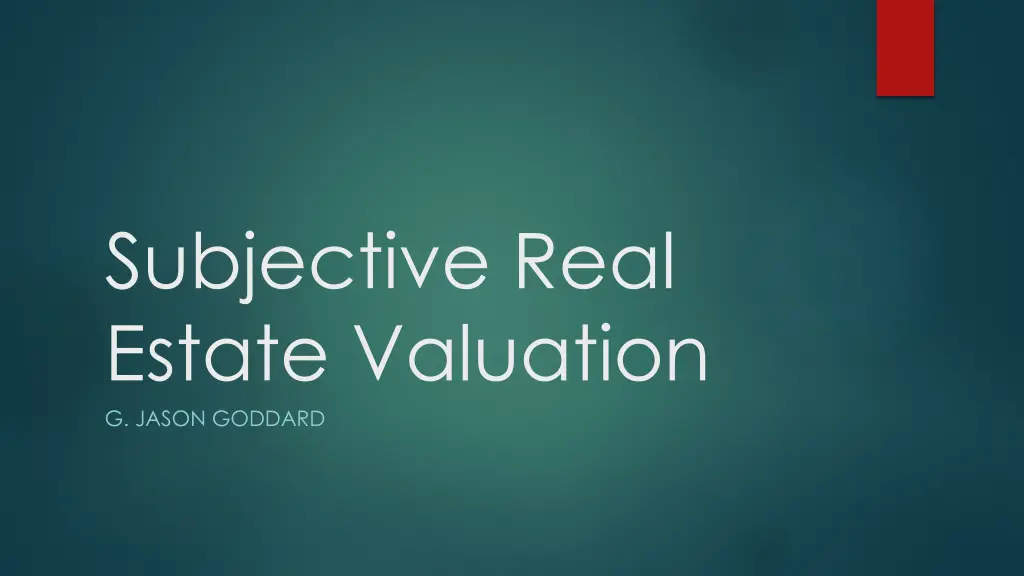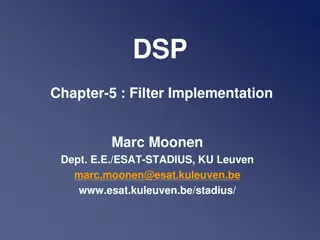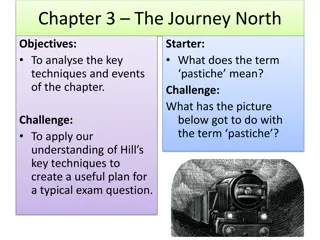
Understanding Housing Valuation and Market Dynamics
Explore the intricacies of housing valuation, market models, regulations, and consumer behaviors in the real estate industry. Delve into the factors influencing home purchases, investment decisions, and the impact of regulations on housing markets.
Uploaded on | 3 Views
Download Presentation

Please find below an Image/Link to download the presentation.
The content on the website is provided AS IS for your information and personal use only. It may not be sold, licensed, or shared on other websites without obtaining consent from the author. If you encounter any issues during the download, it is possible that the publisher has removed the file from their server.
You are allowed to download the files provided on this website for personal or commercial use, subject to the condition that they are used lawfully. All files are the property of their respective owners.
The content on the website is provided AS IS for your information and personal use only. It may not be sold, licensed, or shared on other websites without obtaining consent from the author.
E N D
Presentation Transcript
Subjective Real Estate Valuation G. JASON GODDARD
Chapter 3 Outline Chapter Highlights Housing boom revisited Looking for that special something-how different people value things differently Pitfalls of home valuation
Housing Boom Models Classical housing boom models Friedman, Malkiel Keynes Austrian School of Economics Mises and Hayek Alternative Models Minsky Cantillon Effect: When a government targets specific industries for stimulus (whether housing or otherwise) the effect is typically a rise in asset prices in the associated industries, as these market participants have received stimulus money while others have not.
Housing Boom Participants Buyers and Sellers of real estate Real estate agents and brokers Lenders Central Banks Appraisers Regulators
Housing Regulations (USA) Housing Regulation Alphabet Soup Regulation Title Purpose Regulation B Regulation C* Regulation M Regulation P* Regulation V Regulation Z Regulation AA* Unfair & Deceptive Practices Act Regulation BB Community Reinvestment Regulation DD Truth in Savings * denotes replaced by Dodd-Frank Equal Credit Opportunity Act (ECOA) Home Mortgage Disclosure Consumer Lending Privacy of Consumer Information Fair Credit Reporting Truth in Lending
The Minksy Moment in Housing Housing Boom: An increase in housing prices fueled by demand, speculation, and exuberant spending.
Aesthetics of Housing Options Home as Investment or Consumption? Speculative investment Rent vs. Buy decision Conspicuous Consumption, Leisure and the Veblen Effect Family size and composition effects on home purchases Layouts, garages, room for growth
Socio-Demographic Models of Home Consumption Housing Ladder: Model used todescribe the differences in housing from cheapest to more expensive housing. Housing Life-Cycle: Model used to describe how the changes in the size, composition, and housing preferences are correlated to the different stages of the nuclear family. Housing Life-Course: Model used to describe housing preferences based on familial considerations, education, and career choices.
Sales Approach Subjectivity Subjectivity of Sales Approach for Residential Property Property Sales Date Sales Price Gross Living Area (sq ft) Sales price psf Subject NA NA Comparable 1 Comparable 2 Comparable 3 Comp Avg. 8/8/2021 209,000 $ 110.93 $ 7/25/2021 235,000 $ 105.29 $ 6/25/2021 235,000 $ 102.13 $ 226,333.33 $ 106.12 $ 2,148 1,884 2,232 2,301 2,139 Subject Property and Comparables for Residential Home Sale
Sales Approach Subjectivity Property Value Adjustments Sales/Financing Concessions Location Leasehold/Fee Simple Site (acres) View Design (Style) Quality of Construction Actual Age (years) Condition Total Rooms Total Bedrooms Total Baths Gross Living Area (sq ft) Basement & Finished Rooms Below Grade Functional Utility Heating & Cooling Energy Efficiency Garage/Carport Porch/Patio/Deck Fireplace Pool Sunroom Net adjustment Total Adjusted Sales Price Adj Sales Price psf Subject Subject None Avg. Fee Simple 0.50 Avg. Ranch Avg. 35 Avg. 9 4 2 Partial Part Fin Avg. HVAC Avg. 2 Car Gar Patio 2 Inground Yes Comparable 1 Comparable 2 Comparable 3 Comp Avg. Description FHA $5,000 Avg. Fee Simple 0.90 Avg. Ranch Avg. 40 Avg. Adjust $ (5,000.00) $ Description None Avg. Fee Simple 0.45 Avg. Ranch Avg. 38 Avg. 7 3 2 Adjust $ $ Description None Avg. Fee Simple 0.50 Avg. Ranch Avg. 36 Avg. Adjust $ $ - - Avg. Fee Simple 0.62 Avg. Ranch Avg. 38 Avg. 8 3 2 (1,200.00) $ $ $ $ $ $ $ $ $ $ - - - - - $ $ $ $ $ - - - - - - - - - 7 3 2 9 4 2 (2,500.00) $ (3,800.00) $ 2,456 2,765 Full 6,600.00 $ (4,000.00) $ (5,000.00) $ $ $ $ 11,000.00 $ (2,000.00) $ $ $ 4,000.00 $ 4,400.00 $ 213,400.00 $ 113.27 $ 2,550 (2,100.00) $ 2,845 2,720 Part Fin/Bath Avg. HVAC Avg. Carport Deck/Porch 2 Inground None Finish Bath Avg. HVAC Avg. 2 Car Gar Patio 2 None None (7,500.00) $ $ $ $ 1,000.00 $ $ $ 5,000.00 $ 4,000.00 $ 400.00 $ 235,400.00 $ 105.47 $ Finish Bath Avg. HVAC Avg. 2 Car Gar Pat/DeckPorch 2 None Yes (7,500.00) $ $ $ $ 1,000.00 $ (4,000.00) $ $ 5,000.00 $ $ (11,800.00) $ 223,200.00 $ $ - - - - - - - - - Avg. HVAC Avg. - - - - - 2 - $ $ 226,068 105.25 224,000.00 $ 105.25 $ 97.00 Sales Approach Valuation Subjectivity
Gross Income Multiplier Subjectivity Often utilized as income approach in owner occupied home appraisals Require market rent assumption for local area homes Require multiplier by which homes have sold relative to the gross income produced Best for rental properties given focus on income
Cost Approach Subjectivity Unit Cost Cost New Base Building Costs Building (Sq ft) Total Base Building Costs 2,456 2,456 56.25 $ $ $ 138,141 138,141 Additions/Site Improvements Swimming Pool & Decking Curb & Gutter Landscaping Total Site Improvements Units/Size Unit Cost Cost New 20,000 5,500 6,500 32,000 $ $ $ $ Furniture, Fixtures, and Equipment Description Kitchen Appliances Total FF&E Units/Size 1 Unit Cost 6,465 $ Cost New $6,465 6,465 $ Building Improvements Site Improvements Appliances/FF&E Subtotal $ $ $ $ 138,141 32,000 6,465 176,606 Entrep Profit and Soft Costs Entrep Profit (% of hard costs) Soft Costs (% of hard costs) Replacement Cost New 10% 5% $ $ $ 17,014 8,507 202,127 Depreciated Cost Estimated Land Value Estimated Value by Cost Approach Estimated Value (Rounded) $ $ $ $ 202,127 20,000 222,127 222,000 Cost Approach Valuation Subjectivity
Chapter 3 Questions Questions for Discussion Differentiate between classical and alternative housing boom models and provide examples of each of the components in those models witnessed in the real world. Which of the government regulations noted in the chapter might be most likely to contribute to a run up in housing prices? Should an owner-occupied home be considered an investment or consumption? Take a position and defend. Provide examples of conspicuous consumption, leisure, and waste as related to residential properties. Describe the differences and similarities among the Housing Ladder, Housing Life-Cycle, and Housing Life-Course models of home consumption.
Chapter 3 Questions Questions for Discussion Is an update to the housing consumption models needed in the 21st century? If so elaborate on the suggested improvements and if not describe why these models are still accurate. Describe how the selection of comparable properties for the sales approach can be fraught with subjectivity. Describe the subjectivity related to the adjusted sales price per square foot in the sales approach. Describe the subjectivity related to the gross income multiplier approach. Describe the subjectivity related to the cost approach valuation method.
Chapter 3 Market Vignette Questions for Discussion Does this small mountain town exhibit any signs of a possible housing bubble? Which symptoms highlighted in this chapter are most prevalent in this case? Which socio-demographic housing model can best be utilized in describing the buyer in this case? Is now the time to buy? What would you tell Fred and Barney? How might you critique the sales approach of Chad in this case?






















